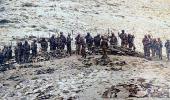In a major technology push, Indian Army has envisioned construction of "permanent defences" along the Line of Actual Control in eastern Ladakh using cutting-edge 3D printing technology, a move that will save time and improve its defence preparedness, sources said on Tuesday.

3D printing technology uses complex software and robotic unit that help in creating a structure through multiple stages from a digital model.
These 3D-printed permanent defences can withstand direct fire by a T-90 tank from about 100 metres, they said.
Sources in the defence establishment said since the eastern Ladakh border standoff in 2020, shelters for about 22,000 troops have come up in the last two years, and these are relocatable, modern, compact, and can be lifted and erected in a few days.
The army has taken a number of steps to boost its capability development and achieve modernisation, and sources said trials on the use of 3D printed defences have been successful.
Besides building habitat for 22,000 troops, shelters for storing equipment have been constructed in the last two years. Nearly 450 vehicles and guns can be stored in these shelters, the sources said.
The focus has now been shifted to "undertake construction of permanent defences and infrastructure to improve defence preparedness" in extant working season apart from completion of ongoing projects in eastern Ladakh, they said.
The infusion of new technology is the key to achieve modernisation, they said, adding that 3D printing technology can help save time and cut cost compared to what is needed in construction of conventional units, like a bunker or a habitat for troops.
The eastern Ladakh border standoff had erupted on May 5, 2020, following a violent clash in the Pangong lake area. Both sides gradually enhanced their deployment by rushing in thousands of soldiers as well as heavy weaponry.
As part of a five-day disengagement process, Indian and Chinese militaries on September 12 this year moved back their frontline troops to the rear locations from the face-off site of Patrolling Point 15 in the Gogra-Hotsprings area in eastern Ladakh and dismantled temporary infrastructure there.
On the sustenance of Indian troops in harsh winters during this period, the sources said some of the shelters were made at 15,000 ft and 17000 ft for round-the-clock deployment, and hence drinking water, especially at high altitude, was a challenge in sub-zero temperature.
Water was accessed from below ponds whose surfaces had icing, and water was still made available to troops in Daulat Beg Oldi throughout winter, they said.
"Also, these habitats were made over two years for troops' convenience, and these are modular, relocatable structures. Solar fuel cells were procured for providing power," a source said.
They also said 'assault bridges' are coming up in a big way as part of the infrastructure push.
The recently inducted new generation plant equipment such as heavy excavators, spider excavators and light weight crawler rock drills were gainfully employed to expedite the progress in forward connectivity, sources said.
Nearly 150 km of operational tracks have been constructed in Northern Command, including permanent works like drains, surface and causeways constructed concurrently to enhance their longevity.
A 298 km road, projected to be completed in 2026, will provide alternate connectivity to western Ladakh and the Zanskar Valley directly from the Manali axis. It also includes a 4.1 km twin tube Shinkun La tunnel for providing all weather connectivity, which is likely to be approved by the defence ministry soon, the sources said.
They added that under the Border Roads Organisation (BRO), there are 18 projects spread across the length and breadth of the country.
BRO has constructed more than 60,000 km of roads, 693 major permanent bridges totalling a length of 53,000 metres, 19 airfields and four tunnels running a total distance of nearly 19 km, including the Atal Tunnel which holds the world record for being the longest tunnel (9.02 km) in the world above 10,000 feet for the world's highest motorable road over Umlingla.
Currently, the BRO is constructing nine tunnels which include the 2.535 km long Sela tunnel, which will be the highest bi-lane tunnel in the world when completed. Eleven more tunnels are under planning, the sources said.











 © 2025
© 2025